Directions (1-5): The question given below is followed by two statements numbered I and II. You have to decide whether the data provided in the statements sufficient to answer the question.
Q1. There are six persons namely, M through R of different ages. Who is the oldest person?
Statements:
I. Q is older than M, who is older than O. R is younger than P.
Il. P is older than Q. N is not the oldest person.
(a) If the data in the statement I alone is sufficient to answer the question, while the data in statement II alone is not sufficient to answer the question.
(b) If the data in the statement II alone is sufficient to answer the question, while the data in statement I alone is not sufficient to answer the question.
(c) If the data either in the statement I alone or in statement II alone is sufficient to answer the question.
(d) If the data in both the statements I and II together are not sufficient to answer the question.
(e) If the data in both the statements I and II together are necessary to answer the question.
Q2. Six boxes, D, E, F, J, K and L are placed one above another but not necessarily in the same order, where the bottommost box is numbered as 1 and the box just above it is numbered as 2 and so on. Which box is placed at the topmost position?
Statements:
I. D is placed 2nd to the above of K, which is placed just above of E. Two boxes are placed between K and L.
II. J is placed above D. F is not placed at the even numbered position.
(a) If the data in the statement I alone is sufficient to answer the question, while the data in statement II alone is not sufficient to answer the question.
(b) If the data in the statement II alone is sufficient to answer the question, while the data in statement I alone is not sufficient to answer the question.
(c) If the data either in the statement I alone or in statement II alone is sufficient to answer the question.
(d) If the data in both the statements I and II together are not sufficient to answer the question.
(e) If the data in both the statements I and II together are necessary to answer the question.
Q3. Six persons (W, X, Y, Z, U and V) are sitting around a circular table facing towards the center of the table but not necessarily in the same order. Who sits 2nd to the right of W?
Statements:
I. V sits adjacent to U. U sits 2nd to the left of W. X sits 2nd to the left of V.
II. U sits 2nd to the right of Z. Y sits adjacent to W.
(a) If the data in the statement I alone is sufficient to answer the question, while the data in statement II alone is not sufficient to answer the question.
(b) If the data in the statement II alone is sufficient to answer the question, while the data in statement I alone is not sufficient to answer the question.
(c) If the data either in the statement I alone or in statement II alone is sufficient to answer the question.
(d) If the data in both the statements I and II together are not sufficient to answer the question.
(e) If the data in both the statements I and II together are necessary to answer the question.
Q4. Eight boxes A, B, C, D, Q, R, S and T are kept one above another but not necessarily in the same order. The bottommost box is numbered as 1 and the topmost box is numbered as 8. How many boxes are kept between Box A and Box R?
Statements:
I. Only three boxes are kept below Box B. Three boxes are kept between Box B and Box T. Box R is kept at one of the places above Box N.
II. Only three boxes are kept between Box Q and Box R. Only one box is kept between Box R and Box D.
(a) If the data in the statement I alone is sufficient to answer the question, while the data in statement II alone is not sufficient to answer the question.
(b) If the data in the statement II alone is sufficient to answer the question, while the data in statement I alone is not sufficient to answer the question.
(c) If the data either in the statement I alone or in statement II alone is sufficient to answer the question.
(d) If the data in both the statements I and II together are not sufficient to answer the question.
(e) If the data in both the statements I and II together are necessary to answer the question.
Q5. Eight persons J, K, L, M, N, G, H, and I are born on 1st in the different months from January to August but not necessarily in the same order. Who is the youngest among them?
Statements:
I. Two persons born between N and G, who was born immediately after I.
II. M was born before I but after H.
(a) If the data in the statement I alone is sufficient to answer the question, while the data in statement II alone is not sufficient to answer the question.
(b) If the data in the statement II alone is sufficient to answer the question, while the data in statement I alone is not sufficient to answer the question.
(c) If the data either in the statement I alone or in statement II alone is sufficient to answer the question.
(d) If the data in both the statements I and II together are not sufficient to answer the question.
(e) If the data in both the statements I and II together are necessary to answer the question.
Directions (6-8): Answer the questions based on the information given below.
Seven persons are sitting at some distance from each other. W is sitting 4m west to X. T is sitting 2m north to S, who is sitting 4m west to Q, who is sitting 1m north to V. W is sitting 2m north to Y. Y is sitting 8m west of T.
Q6. What is the direction of X with respect to Q?
(a) North-east
(b) South-east
(c) North
(d) North-west
(e) None of these
Q7. What is the shortest distance between W and V?
(a) 13m
(b) 15m
(c) 11m
(d) 9m
(e) 8m
Q8. What is the direction of S with respect to W?
(a) North-east
(b) South-east
(c) South-west
(d) North-west
(e) None of these
Directions (9-10): Answer the questions based on the information given below.
In a certain code,
A & B means A is 9m west of B.
A % B means A is 4m south of B.
A * B means A is 7m north of B.
A @ B means A is 5m east of B.
Q9. In expression ‘M&N%A%C&O*P*Q’, then Q is in which direction with respect to C?
(a) North-east
(b) South-east
(c) South-west
(d) North-west
(e) None of these
Q10. In expression ‘P&R&T@S%Q*L*M’, what is shortest distance between P and L?
(a) √178m
(b) √176m
(c) √185m
(d) √204m
(e) None of these
Directions (11-15): The question given below is followed by two statements numbered I and II. You have to decide whether the data provided in the statements sufficient to answer the question.
Q11. Seven persons A, B, C, D, E, F& G live on different floors of a seven-storey building but not necessarily in the same order. The bottommost floor is numbered as 1 & the topmost floor is numbered as 7. How many persons live between G and B?
Statements:
I. E lives three floors above C, who lives on an even numbered floor. F lives two floors above B. A lives immediately below D.
II. One person lives between C and D. E doesn’t lives below C. B doesn’t live on 1st floor.
(a) If the data in the statement I alone is sufficient to answer the question, while the data in statement II alone is not sufficient to answer the question.
(b) If the data in the statement II alone is sufficient to answer the question, while the data in statement I alone is not sufficient to answer the question.
(c) If the data either in the statement I alone or in statement II alone is sufficient to answer the question.
(d) If the data in both the statements I and II together are not sufficient to answer the question.
(e) If the data in both the statements I and II together are necessary to answer the question.
Q12. Eight persons H, I, J, K, L, M, N & O join classes on 1st of different months (May – Dec) in the same year but not necessarily in the same order. Who joins immediately before I?
Statements:
I. N joins immediately before H. J joins before N, but not in May. L joins before September.
II. O joins at least two months after I. More than three persons join between N and K. N joins after Aug.
(a) If the data in the statement I alone is sufficient to answer the question, while the data in statement II alone is not sufficient to answer the question.
(b) If the data in the statement II alone is sufficient to answer the question, while the data in statement I alone is not sufficient to answer the question.
(c) If the data either in the statement I alone or in statement II alone is sufficient to answer the question.
(d) If the data in both the statements I and II together are not sufficient to answer the question.
(e) If the data in both the statements I and II together are necessary to answer the question.
Q13. There are seven members in a family, which consists of three generations. Who is the mother of Z?
Statements:
I. Z is the only grandson of A, who is married to H, who has one son and one daughter.
II. I is in same generation as Y, who is the uncle of Z.
(a) If the data in the statement I alone is sufficient to answer the question, while the data in statement II alone is not sufficient to answer the question.
(b) If the data in the statement II alone is sufficient to answer the question, while the data in statement I alone is not sufficient to answer the question.
(c) If the data either in the statement I alone or in statement II alone is sufficient to answer the question.
(d) If the data in both the statements I and II together are not sufficient to answer the question.
(e) If the data in both the statements I and II together are necessary to answer the question.
Q14. Six trees G, H, I, J, K, and L have different heights. Tree H is not the tallest. Which among the following tree is 2nd tallest?
Statements:
I: Two trees are taller than tree G. Tree J is taller than tree I and tree L but not than tree G.
II. Neither tree J nor tree I is the tallest. Tree G is shorter than tree H.
(a) If the data in the statement I alone is sufficient to answer the question, while the data in statement II alone is not sufficient to answer the question.
(b) If the data in the statement II alone is sufficient to answer the question, while the data in statement I alone is not sufficient to answer the question.
(c) If the data either in the statement I alone or in statement II alone is sufficient to answer the question.
(d) If the data in both the statements I and II together are not sufficient to answer the question.
(e) If the data in both the statements I and II together are necessary to answer the question.
Q15. Five boxes P, Q, R, S and T are kept one above another such that bottommost box is numbered as 1, box just above it is numbered as 2 and so on. Which among the following is topmost box?
Statements:
I. Box Q is just above box S. Box P is two boxes above box T.
II. Box R is even numbered box. Only box Q is above box S.
(a) If the data in the statement I alone is sufficient to answer the question, while the data in statement II alone is not sufficient to answer the question.
(b) If the data in the statement II alone is sufficient to answer the question, while the data in statement I alone is not sufficient to answer the question.
(c) If the data either in the statement I alone or in statement II alone is sufficient to answer the question.
(d) If the data in both the statements I and II together are not sufficient to answer the question.
(e) If the data in both the statements I and II together are necessary to answer the question.
Solutions
Solution (1-5):
S1. Ans. (e)
Sol. From statements I and II together, we get P > Q > M > O and P > R
Hence, the data in both the statements I and II together are necessary to answer the question.
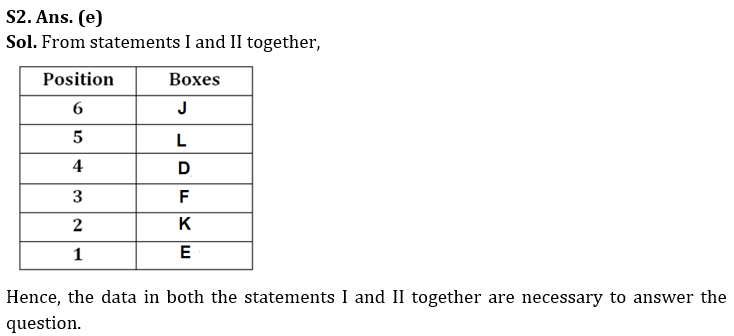
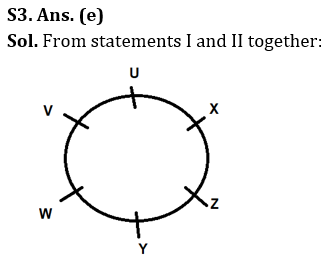
Hence, the data in both the statements I and II together are necessary to answer the question.
S4. Ans. (d)
Sol. From statements I and II together, we get that the place of R is not certain. So, the data in both the statements I and II together are not necessary to answer the question.
S5. Ans. (d)
Sol. From statements I and II together, there is lack of information. So, the data in both the statements I and II together are not necessary to answer the question.
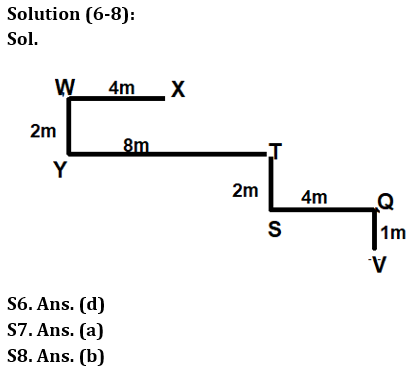
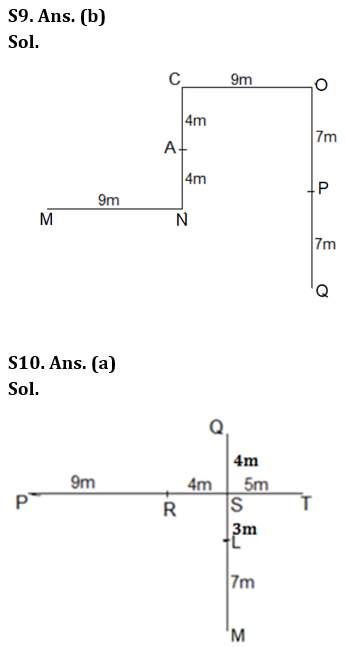
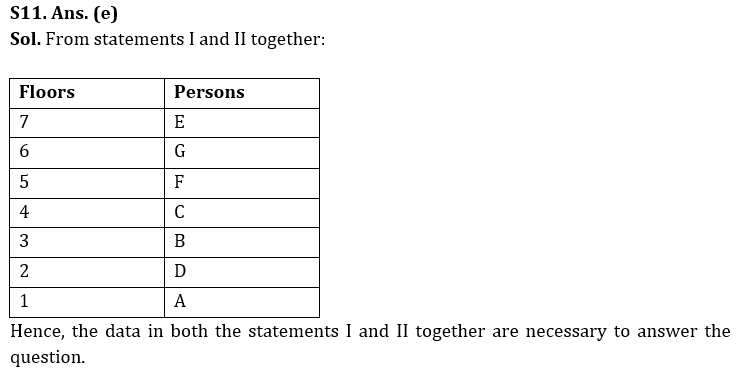
S12. Ans. (d)
Sol. From statements I and II together, there is lack of information. So, the data in both the statements I and II together are not necessary to answer the question.
S13. Ans. (d)
Sol. From statements I and II together, there is lack of information. So, the data in both the statements I and II together are not necessary to answer the question.
S14. Ans. (a)
Sol. From statement I:
K > H > G > J > I/L > L/I
Hence, the data in the statement I alone is sufficient to answer the question, while the data in statement II alone is not sufficient to answer the question.
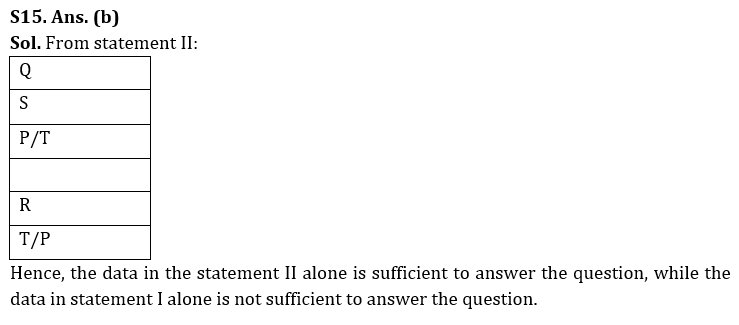



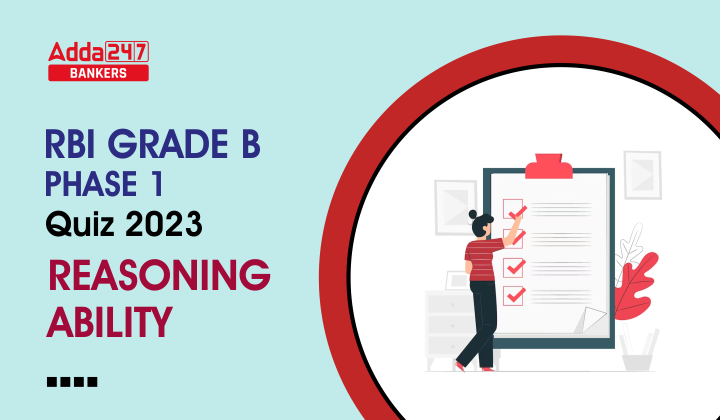

 GA Capsule for SBI Clerk Mains 2025, Dow...
GA Capsule for SBI Clerk Mains 2025, Dow...
 The Hindu Review October 2022: Download ...
The Hindu Review October 2022: Download ...
 Delhi CSIR CRRI Recruitment 2025 Notific...
Delhi CSIR CRRI Recruitment 2025 Notific...







